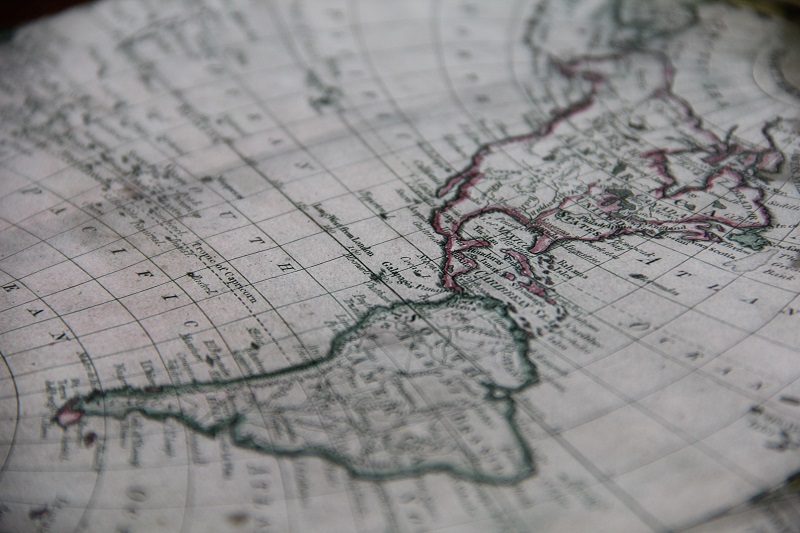The Inter-American Geodetic Survey (IAGS) was established in 1946 by President Harry S. Truman as a U.S. Army organization to assist national governments in mapping their territorial boundaries. The team primarily supported the mapping of countries in Latin and South America.
While fulfilling for those who served, it was also dangerous. Thirty-four individuals lost their lives in support of IAGS during the 43 years the organization existed.
In July 2022, NGA celebrated the 75-year anniversary of the creation of IAGS to remember the impact the team had on mapping and to honor the lives lost with a new permanent memorial. This year, NGA welcomed relatives of those who perished in the line of duty to visit NGA’s Springfield, Virginia campus, June 14, 2023 to see the memorial.
Relatives of IAGS cartographer Raymond Johns – Juliette “Jette” Rouse, granddaughter of Johns and Kyle Rouse, great grandson of Johns, visited NGA.
“My grandfather, Raymond Johns died when I was only six-years old, but he had a larger than life personality that left a big impression on me,” said Jette Rouse. “I have always admired his adventurous spirit and his progressive philosophies. I am very grateful to Jack Hild for initiating the research into the death of my grandfather and his fellow IAGS employees, and to the NGA for honoring them with this memorial. ”
Johns lost his life while deployed to Chile in 1979. Jack Hild, a former NGA employee who championed the idea of the memorial at the agency, and 2022 GEOINT Hall of Fame inductee, told Johns’ story during last year’s 75th anniversary event.
He had deployed to Chile in 1976 to install the first GPS tracking station in the southern zone of Chile. The instrument tracked satellite signals and stored the data on cassette tapes. He was on a mission to retrieve a cassette when their plane crashed. Three Chilean Army officers also died in the accident.
Johns’ name is also engraved on a monument to those lost in the crash in Chile.
The hazardous nature of the mission seems to have faded from the NGA corporate memory according to Hild.
“Travel to survey sites in South America was hazardous, with poor weather conditions and high-altitude missions in the Andes,” said Hild during his keynote at the 75th anniversary ceremony. “Navigating the fjords and rivers and third world maintenance conditions also played a role in the accidents.”
The geographical-focused missions that present-day NGA undertakes certainly are different than they were in the mid-20th Century, but the premise of collaborating with partners for knowledge-sharing and providing expertise is part of NGA’s past and present mission set.
During an interview with Hild, he shared two other projects that highlighted international partnerships and showed the importance of collaboration.
“IAGS never came up when [the Multinational Geospatial C-production Program] was discussed,” said Hild. “But when you factor in Partnership for Peace and Vector Mapping you can probably build a trail from IAGS to the National Imagery and Mapping Agency to the Defense Mapping Agency to NGA [showing] the collaboration with foreign nations to make progress.”
“Lessons learned from the IAGS experience are still applied today, including the importance of establishing partnerships with geospatial organizations in partner nations and that collaboration in the production and sharing of data and analysis benefits all parties,” said Melissa Planert, NGA International Affairs deputy director.
The efforts put forth in building the IAGS program and the lessons learned are demonstrated in the support to Ukraine.
“I simply want to assure you that NGA, following the IAGS model, is leveraging its GEOINT partnerships and ensuring foundational data and products are shared to the fullest extent possible,” said Planert. “The partnerships we have today are enabling support globally to our military and those of our allies, for disaster relief and war zones, demonstrating that the sacrifices endured by those who lost their lives building the IAGS program are still relevant today to U.S. strategic competition and national security objectives.”
To Hild it is important to remember IAGS and the impact the individuals had on the mission. In 2016 he learned about the IAGS mission and began doing research. “I simply couldn’t believe we lost track of what had happened,” said Hild.
To this day he continues to search for descendants of the individuals who lost their lives and works to continuously honor them. Through the new memorial, NGA recognizes Johns and the other IAGS employees who lost their lives while supporting the mission. Many of their stories are captured in the archives at NGA.
Source: NGA
Like IC News? Then please consider subscribing. You’ll get full access to our searchable library of 10,000+ articles, plus new articles each weekday.









